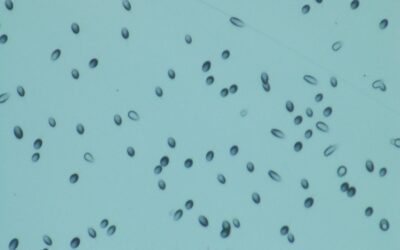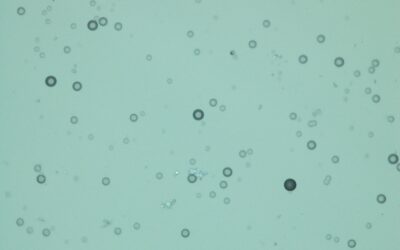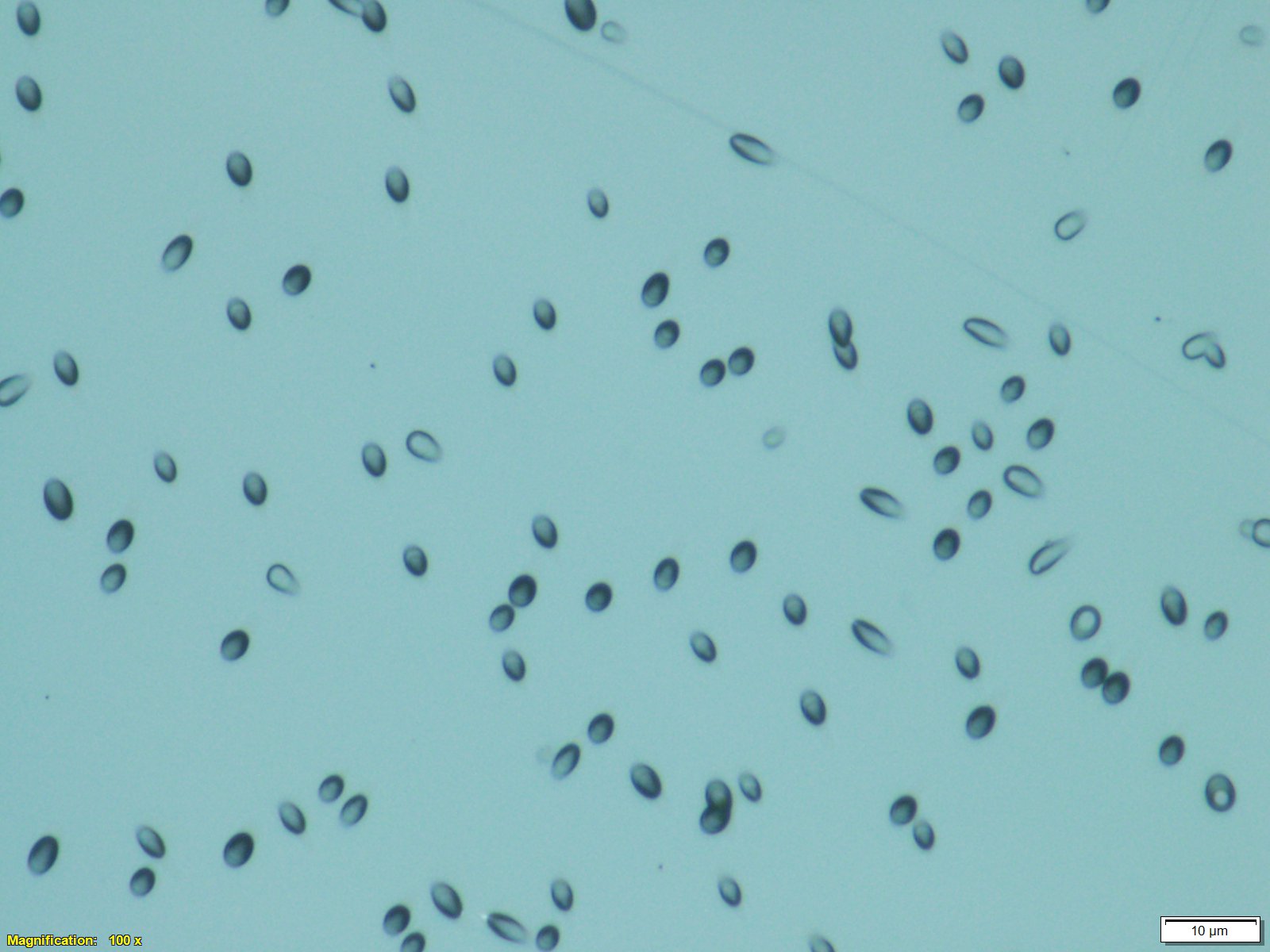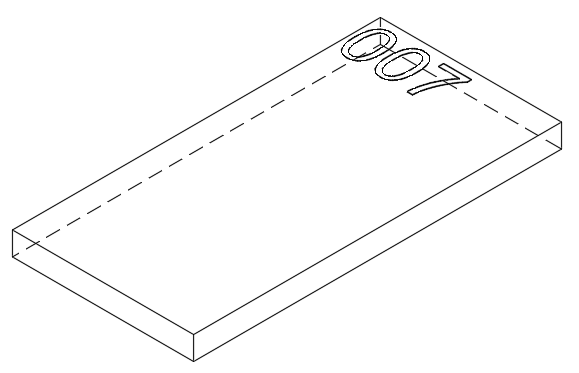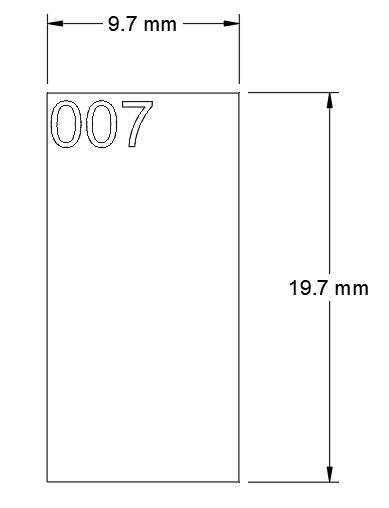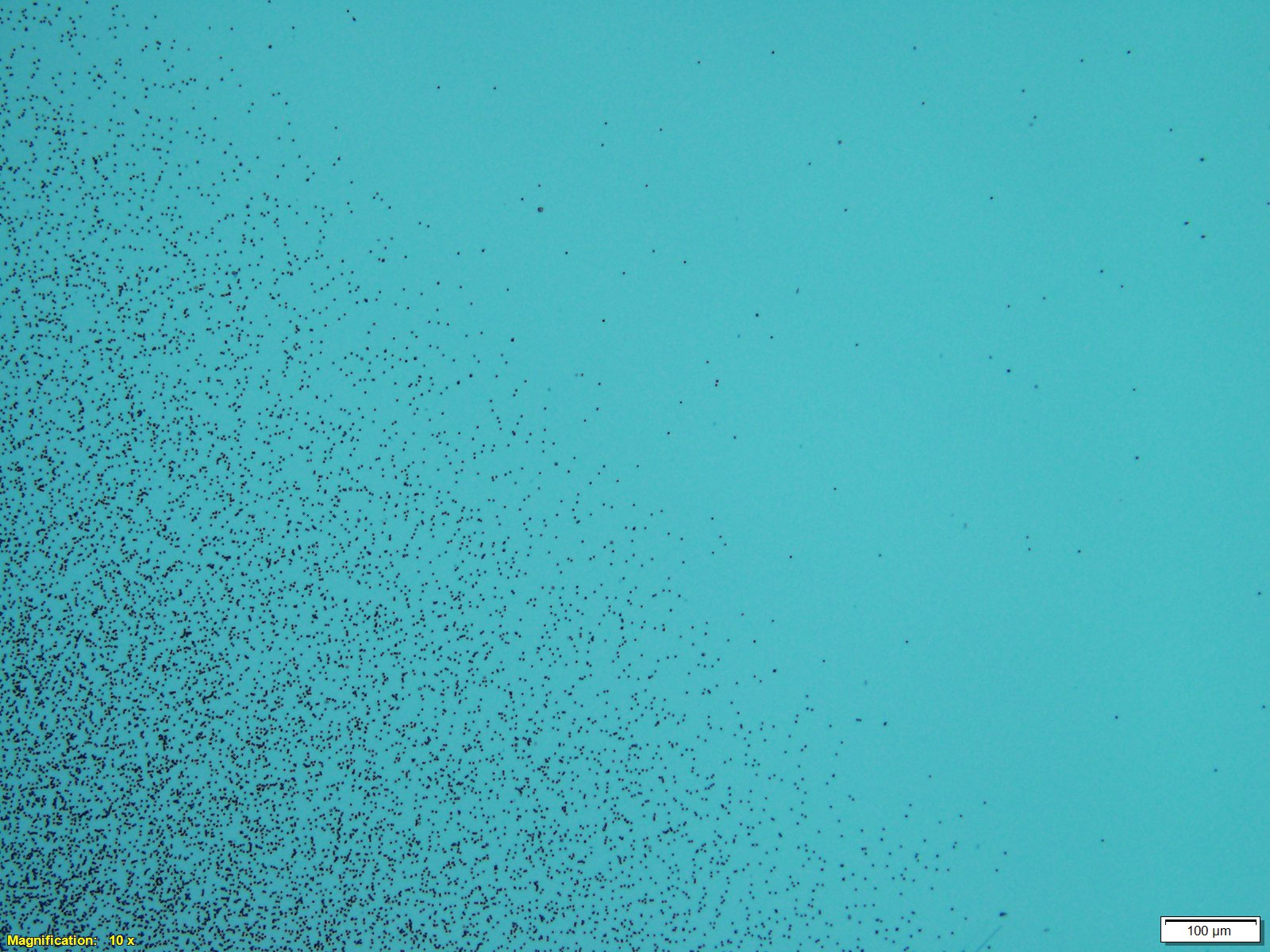Nuclear Detection
We have developed a superior resin for use in nuclear particle track detection. Most of the CR-39 that is sold commercially today is not optimized for use in particle track detection. Our material has excellent polymer cross linkage, so the disruption caused by a charge particle is readily apparent. We have also developed automated feature identification and counting, and very simple etching and polishing procedures to detect more complex particle signatures deeper into the resin, such as the characteristic ‘triple tracks’ from high-energy neutron induced carbon disintegration into three alpha particles. Our CR-39 particle tracks provide an immediate quantitative solution to your radiation detection needs.
We also offer new aerogel technologies for the containment and positioning of nuclear reactants, and for other nuclear applications. Our silicon oxide and graphene aerogels may be manufactured over a wide range of densities and thicknesses to meet the needs of your custom applications. Please contact us to discuss your planned applications in detail.
If you need temporal analysis of incoming radiation levels, or if you are interested in doing neutron or charged particle spectroscopy, then we offer solutions centered on new Silicon Photomultiplier (SiPM) detection of fast light flashes as charged particles strike an optimized scintillator material that has been custom-tailored to your application. These new approaches offer highly integrated and compact design over conventional devices that used large and delicate photomultiplier tubes (PMTs). When coupled with our imbedded microcontroller and programmable gate array technologies on a I2C digital bus, this approach can improve and drastically minimize applications such as positron emission tomography (PET) for brain and cardiac imaging, and a wide range of other ultra-fast nuclear particle detection applications.
Learning Radiation Kit Refill
Learning Radiation Kit Refill $28.00 If you already have the Learning Radiation Kit but need more CR-39, you can purchase 14 pieces of CR-39 to refill the kit. The plastic holders do...
Radioisotopes in Water Test
Radioisotopes in Water Test $35.00 If you drill a water well through natural deposits of uranium, thorium, radium, or radon gas, then you probably have a lot of...
Learning Radiation Kit
Learning Radiation Kit $75.00 With the Learn Radiation Kit, you can see the effects of radiation with your own eyes! Using the thermoset polymer, CR-39, you can expose it to alpha radiation...
CR39
CR-39 for Nuclear Particle Track Detection
CR39 Recommended Best Practice
CR-39 Recommended Best Practice
Learning Radiation Kit Refill
Learning Radiation Kit Refill
$28.00
If you already have the Learning Radiation Kit but need more CR-39, you can purchase 14 pieces of CR-39 to refill the kit. The plastic holders do not become radioactive with use and can be used indefinitely. The thorium in the supplied tungsten-thorium rods has a half-life of 14 billion years, so it will not need to be replaced until a similar amount of time.
With the Learn Radiation Kit, you can see the effects of radiation with your own eyes! Using the thermoset polymer, CR-39, you can expose it to alpha radiation and see exactly where alpha particles hit, its approximate energy, and what direction it was going. When a high energy particle impacts the polymer it breaks bonds and allows for preferential etching during post-exposure processing. These etched tracks can then be observed and characterized under a microscope, or with enough exposure, be seen with the unaided eye.
This item includes:
- (14) CR-39 pieces with protective film
These thorium-tungsten rods contain about 2% thorium-232, which is a very low-level radioisotope that emits alpha particles by radioactive decay. Th-232’s half-life is over 14 billion years, which is longer than the likely age of the universe, making it one of many nearly stable radioisotopes that we call primordial nuclides.
These alpha particles that come from the Th-232 decay are not radioactive, since they are just energetic helium ions that lose their charge once they come to rest and become common helium atoms. But when they are emitted, they are very energetic, with an energy of approximately 4.1 million electron volts (MeV) which is over 160 million times more energetic than their random motion once they slow down. At this energy, the helium atom loses both of electrons, so they are ions with a charge of +2e, and traveling at about 0.4% of the speed of light.
Click here for more information for best practice for the use of CR-39.
Click here for electron microscope web application image. This image is of our CR-39 exposed to Am-241 alpha particles. Notice the direction of impact and depth of penetration. Here is the same image with AI labeling of features.
Radioisotopes in Water Test
If you drill a water well through natural deposits of uranium, thorium, radium, or radon gas, then you probably have a lot of these radioactive materials in your drinking water. If you live in uranium country (Western New Mexico, Saskatchewan, Odisha, India, etc.) or near a known nuclear spill (Chernobyl, Fukushima, etc.), you probably would like the peace of mind of knowing that your drinking water is safely low in radioactive materials. Radon gas comes primarily from uranium decay, so if you are concerned about radon in your basement, then you should also test your water well for radioisotopes.
Fortunately, BSI now offers a simple to use, inexpensive test kit to check for alpha-emitting radioisotopes in your drinking water. You can send us a sample of your water, or of the salt water that your water softener expels when it regenerates, and we will send you back a confidential report describing the amount of alpha emitting materials that we found in your sample. We will also provide you with copies of federal publications from the National Institutes of Health (NIH) and affiliated organizations that describe the risk level associated with your water, and what you can do if this risk is too high. Alternatively, we can sell you the necessary equipment to process your test kit yourself (DIY). This is a good option if you want to run many routine tests and preserve absolute confidentiality within your own laboratory.
Contact us today, or send us a sample of your water (up to a gallon) to be tested, along with the order form below. We will respond soon with a detailed report on alpha particle emitting radioisotopes in your water.
Learning Radiation Kit
Learning Radiation Kit
$75.00
With the Learn Radiation Kit, you can see the effects of radiation with your own eyes! Using the thermoset polymer, CR-39, you can expose it to alpha radiation and see exactly where alpha particles hit, its approximate energy, and what direction it was going. When a high energy particle impacts the polymer it breaks bonds and allows for preferential etching during post-exposure processing. These etched tracks can then be observed and characterized under a microscope, or with enough exposure, be seen with the unaided eye.
We will gladly develop, image, and characterize your CR-39 particle track detectors, if you would like us to do so. We charge $159.99 to process all 14 of the CR-39 particle track detectors in the Teaching Radiation kit and to provide you with the digital images of the detectors, provided we process all 14 detectors simultaneously. For other development pricing, please contact BSI.
This kit includes:
- (14) CR-39 pieces with protective film
- (2) 2% Thorium-tungsten rod
- (1) Varied distance 3D printed holder
- (1) Varied time 3D printed holder
- Instructions on its use, safety procedures, teaching aid and worksheet
Alternatively, we will be happy to sell you the necessary apparatus to do this development and analysis on your own. This is what we call the ‘Do It Yourself (DIY) Option, and we recommend it for those who would like to teach the Learning Radiation module to multiple classes for many years to come. Please see our DIY kit pricing below. We are also available to assist you in re-applying your existing equipment to DIY.
These thorium-tungsten rods contain about 2% thorium-232, which is a very low-level radioisotope that emits alpha particles by radioactive decay. Th-232’s half-life is over 14 billion years, which is longer than the likely age of the universe, making it one of many nearly stable radioisotopes that we call primordial nuclides.
These alpha particles that come from the Th-232 decay are not radioactive, since they are just energetic helium ions that lose their charge once they come to rest and become common helium atoms. But when they are emitted, they are very energetic, with an energy of approximately 4.1 million electron volts (MeV) which is over 160 million times more energetic than their random motion once they slow down. At this energy, the helium atom loses both of electrons, so they are ions with a charge of +2e, and traveling at about 0.4% of the speed of light.
Option 1: BSI will provide you with a development kit for $599.00 to chemically process your CR-39 particle track detectors. You will need to separately purchase your own sodium hydroxide, and to follow the heating instructions carefully using the hot plate that we provide while following our safety instructions carefully.
Option 2: BSI will sell you a reconditioned optical microscope with an ocular camera and a computer interface for $1,299. This includes the cost of a new lap-top, loaded with the imaging and image analysis software that you will need to understand your results. Please see the image of this DIY system, below. Please note that that the actual reconditioned optical microscope may vary, but it will be fully adequate to support your DIY activities. This system will be able to assist the user by counting the number of tracks in a reference area. For an additional price, BSI can provide advanced AI-based analysis tools which differentiate between different particle tracks, particle arrival angles, and particle energies, and to provide displays showing the distribution of these traits within the observed particle tracks. Please contact BSI if you would like us to work with you to develop custom analysis software for your specific research applications.
Click here for more information for best practice for the use of CR-39.
Click here for electron microscope web application image. This image is of our CR-39 exposed to Am-241 alpha particles. Notice the direction of impact and depth of penetration. Here is the same image with AI labeling of features.
CR39
CR-39 for Nuclear Particle Track Detection
The thermoset polymer, CR-39, is used in nuclear particle tracing and calorimetry as a solid state nuclear track detector (SSNTD). When a high energy particle impacts the polymer it breaks bonds and allows for preferential etching during post-exposure processing. These etched tracks can then be observed and characterized under a microscope.
CR-39 is sensitive to many particles such as energetic protons, alpha-particles and heavier ions, and fast neutrons. Thermal/epithermal neutrons can be detected by doping CR-39 with boron to produce the 10B(n,a)7Li reaction and subsequent alpha-particle detection.
This SSNTD has a wide variety of applications of radiation measurement, including home radon detection, dosimetry, and is a less visceral display of radiation damage for educators.
Click here for more information for best practice for the use of CR-39.
Click here for electron microscope web application image. This image is of our CR-39 exposed to Am-241 alpha particles. Notice the direction of impact and depth of penetration. Here is the same image with AI labeling of features. Here is an image of U-238 fission fragment tracks boxed in cyan.
SEM image of 14 MeV neutron-induced proton-recoil (magenta) and U-238 fission fragment (cyan) with AI detection.
CR39 Recommended Best Practice
CR-39 Recommended Best Practice
All CR-39 squares should be stored well away from radiation sources in a cool-dry environment, and temperatures not to exceed 86°F (30°C).
CR-39 may be used to measure the particle tracks and accumulated radiation exposure history from alpha particles, other charged particles of adequate mass, and from the recoil of protons in the CR-39 that are struck by energetic neutrons. In addition, for the detection of thermal neutrons, a thin boron layer coating may be requested on one side of the CR-39 to produce charged lithium-7 and alpha particles when the boron captures the thermal neutron. The comparison of the boron-coated side of the CR-39 to its opposite bare side provides an accurate estimate of the thermal neutron flux in most radiation measurement environments.
CR-39 squares are delivered in a hermetically-sealed thin plastic package with a secondary protective film on both sides that will block all alpha particles, and that will keep all alpha emitting gasses from accessing the CR-39. We recommend that you apply two squares to each measurement. Keep one sealed as delivered in close-proximity (the control square) to the square that you strip out of its hermetic seal to use to make your measurements (the experimental square). Once your measurement are complete, place both the control and the experimental square into the pouch provided, and ship both back to BSI for processing and analysis. Only the experimental square will detect alpha particles (and possibly other charged particles) from your experiment, while the control will detect the energetic neutron flux from your experiment (if any), and possibly the high-energy neutrons generated by solar geomagnetic storms and other sources of neutron radiation from the environment surrounding your apparatus. It will also detect neutrons from these environmental sources during shipping from / to your site, and while in storage.
If you plan to detect fusion neutrons from DT reactions, or neutrons from any other source that are expected to exceed 8 MeV in kinetic energy, then we encourage you request a more advanced analysis that will image and count tracks at the surface to detect alpha particles and epithermal neutrons as usual, followed by a deep etch (to at least 300 microns below the surface) to detect ‘triple-track’ alpha particles that are produced by these high energy neutrons as they disintegrate carbon atoms in the CR-39. These deep interactions are produced only by highly energetic neutrons, and they occur with equal probability throughout the bulk of the CR-39 squares. We recommend that you contact BSI for a brief consultation to assure that we prepare and analyze your CR-39 squares in the most appropriate way to accurately support your planned measurement protocols.
5.5 MeV alpha particles striking the CR-39 from various angles.
5.5 MeV alpha particles with energies moderated by passing through aerogel.
Alpha particles striking CR-39 through a large aperture.
Overexposure of CR-39 to alpha particles.


